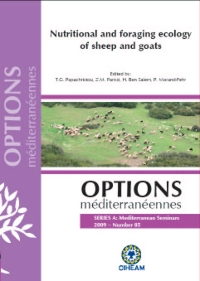| Article précédent | p. 285-290 | Article suivant |
Changes in ruminal fermentation in sheep fed either alfalfa hay or grass hay after changing to a high-concentrate diet
Four rumen-fistulated Merino sheep were used in a crossover design experiment with two 44-day periods each to evaluate the changes in ruminal parameters including enzymatic activities that occur after an abrupt change from a 70:30 forage:concentrate diet (HF) to a 30:70 forage:concentrate diet (HC) when forage was either alfalfa hay (AL) or grass hay (GR). Sheep were fed the diets at a daily rate of 55 g/kg body weight0.75. During the first 15 days of each experimental period sheep were fed HF diets, and from day 16 thereafter they received HCAL and HCGR. On days 0, 2, 5, 12, 20 and 28 after diet change, ruminal samples from each sheep were collected 3 h after feeding. There were no differences (P > 0.05) between diets (HCAL and HCGR) in any of the measured variables, with the exception of NH3-N and total short chain fatty acid (SCFA) concentrations which were greater (P < 0.001 and 0.028) for HCAL than for HCGR. For both diets, ruminal pH decreased significantly 2 days after the change to HC diets, and values continued being lower (P < 0.001) 28 days after the diet change. Total SCFA concentrations increased (P < 0.05) by 19 and 24% for HCAL and HCGR, respectively, on day 2, but values on day 28 did not differ (P > 0.05) from those on day 0. No effect (P > 0.05) of diet change was observed on endoglucanase, exoglucanase and xylanase activities in ruminal fluid on day 2, but activities of all these enzymes increased (P < 0.05) by day 28. Amylase activity increased (P < 0.05) on day 2 for diet HCAL and remained greater (P < 0.05) for the rest of the trial. For diet HCGR, amylase activity increased (P < 0.05) on day 12 and remained greater through to the end of the trial.
Quatre moutons de race Mérinos, munis de canules ruminales, ont été utilisés pour évaluer les variations des paramètres de fermentation ruminale et les activités enzymatiques qui se produisent après le changement brusque d'une ration 70:30 fourrage:concentré (HF) à une ration 30:70 fourrage:concentré (HC). Le foin de luzerne (AL) ou le foin d'herbe (GR) étaient utilisés comme fourrage, selon un dispositif en cross-over, avec deux périodes de 44 jours chacune. Les ovins ont reçu 55 g/kg0,75 par jour de chacune des rations. Pendant les 15 premiers jours de chaque période expérimentale, les animaux ont reçu les rations HF, et à partir du jour 16, ils ont reçu HCAL et HCGR. Des échantillons du jus de rumen de chaque mouton ont été prélevés pendant les jours 0, 2, 5, 12, 20 et 28 après le changement de régime, 3 h après la prise d'aliment. Il n'y a eu aucune différence (P > 0,05) entre les rations (HCAL et HCGR) pour les différentes variables mesurées, sauf pour l'azote ammoniacal et les concentrations d'acides gras à courtes chaînes (SCFA), qui étaient plus élevés (P < 0,001 et P < 0,028) pour HCAL que pour HCGR. Pour les deux régimes, le pH ruminal a nettement diminué pendant les 2 premiers jours après le changement au régime HC, et les valeurs sont restées plus faibles (P < 0,001) 28 jours après. Au deuxième jour, les concentrations en acides gras volatils totaux ont augmenté (P < 0,05) de 19 et 24% pour HCAL et HCGR, respectivement, mais après 28 jours elles ont été similaires (P > 0,05) à celles du jour 0. Aucun effet (P > 0,05) du changement de régime n'a été observé sur les activités d'endoglucanase, d'exoglucanase et de xylanase du jus de rumen le 2ème jour, mais les activités de toutes ces enzymes ont été plus élevées (P < 0,05) au 28ème jour. L'activité d'amylase a augmenté (P < 0,05) le 2ème jour avec le régime HCAL et le 12ème jour avec la ration HCGR et elle est restée plus élevée jusqu'à la fin de l'essai.
- [ Afficher ]
- [ Télécharger ]
- [ Exporter la citation ]
Vous pouvez télécharger la citation au format :
- [ Imprimer ]
-
Mots-clés
ACTIVITE ENZYMATIQUE, ALIMENT CONCENTRE POUR ANIMAUX, DIGESTION DU RUMEN, FERMENTATION, FOIN, FOURRAGE, LUZERNE, MESURE, OVIN, REGIME ALIMENTAIRECiter cet article
Ramos S., Tejido M.L., Martínez M.E., Ranilla M.J., Carro M.D. Changes in ruminal fermentation in sheep fed either alfalfa hay or grass hay after changing to a high-concentrate diet. In : Papachristou T.G. (ed.), Parissi Z.M. (ed.), Ben Salem H. (ed.), Morand-Fehr P. (ed.). Nutritional and foraging ecology of sheep and goats. Zaragoza : CIHEAM / FAO / NAGREF, 2009. p. 285-290. (Options Méditerranéennes : Série A. Séminaires Méditerranéens; n. 85). 12. Seminar on: Nutritional and Foraging Ecology of Sheep and Goats, 2007/10/11-13, Thessaloniki (Greece). http://om.ciheam.org/om/pdf/a85/00801019.pdf



